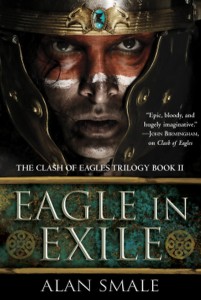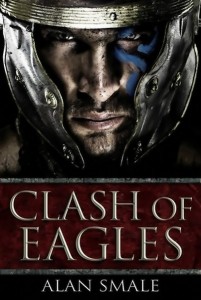I received this book for free from Del Rey in exchange for an honest review. This does not affect my opinion of the book or the content of my review.
 Eagle in Exile by Alan Smale
Eagle in Exile by Alan Smale Published by Del Rey, Titan Books on 22 March 2016
Genres: Type III - Soft, Type IV - Utterly Implausible
Format: eBook
Source: Del Rey
Buy on Amazon
Goodreads

Premise - Point of Divergence (POD)
In 211 AD Geta survives an assassination attempt by his older brother, and co-Emperor Caracalla. Geta wins the following decade long civil war and introduces a number of civil reforms designed to limit his own powers and those of his successors. Military reforms also deter individual legions from aligning themselves with pretenders to the Imperial throne allowing the Roman Empire to continue to flourish, and to successfully weather the subsequent barbarian invasions.
The Story
In A.D. 1218, Praetor Gaius Marcellinus is ordered to conquer North America and turning it into a Roman province. But outside the walls of the great city of Cahokia, his legion is destroyed outright; Marcellinus is the only one spared. In the months and years that follow, Marcellinus comes to see North America as his home and the Cahokians as his kin. He vows to defend these proud people from any threat, Roman or native.
After successfully repelling an invasion by the fearsome Iroqua tribes, Marcellinus realizes that a weak and fractured North America won’t stand a chance against the returning Roman army. Worse, rival factions from within threaten to tear Cahokia apart just when it needs to be most united and strong. Marcellinus is determined to save the civilization that has come to mean more to him than the empire he once served. But to survive the swords of Roma, he first must avert another Iroqua attack and bring the Cahokia together. Only with the hearts and souls of a nation at his back can Marcellinus hope to know triumph.
The Review
This book is where the trilogy really took off for me. No longer concerned with the author’s conceit (defn. a fanciful thought, idea, or expression, especially of a strained or far-fetched nature – see [post2post id=”a-clash-of-eagles”], I just found myself immersed in the story. And what a story!
Once again Marcellinus is the focus of actions that will shape the future of his world, but rather than just the two continents that had clashed in the first book, this time he is the focus for three continents. While I had concerns that in the first book in the series too much was happening to him, in this book he takes history by the neck and bends it into a pretzel.
Surprisingly, given the scale of the events that occur around Marcellinus, this book remains primarily character driven – although I do have to warn you that the number of characters, and the foreignness of their names, makes keeping track of everyone impossible. Something that I am now taking to heart in my own writing.
I particularly liked the developing relationship between Marcellinus and the Emperor, and the way that Kimi, Siski, Tatay, and Enopay continue to grow, and develop.
I look forward with anticipation to reading the next book in the series.

 A Clash of Eagles by
A Clash of Eagles by 